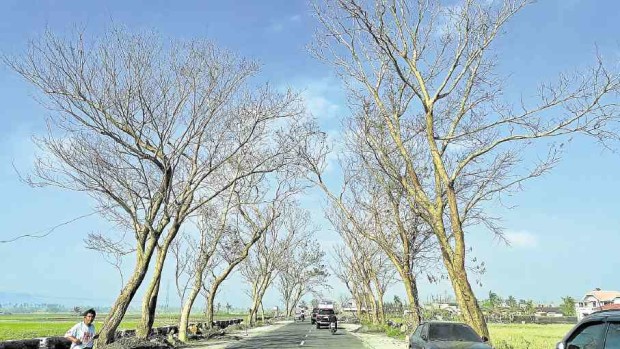P500M set aside for farm rehab

This section of the diversion road in Polangui town in Albay province is famous for its “tree tunnel.” But strong winds accompanying Typhoon “Nina” (international name: Nock-ten) stripped the trees of its leaves, giving motorists an eerie sight. —MARK ALVIC ESPLANA
President Duterte has approved the allocation of an initial P500 million for the rehabilitation of farms in the provinces of Bicol region, which bore the brunt of Typhoon “Nina,” (international name: Nock-ten), Agriculture Secretary Emmanuel Piñol said.
Monitoring by the field operations service of the Department of Agriculture (DA) showed the typhoon ruined P4-billion worth of crops, mostly rice and vegetables, in Southern Luzon.
Piñol said P300 million of the rehabilitation fund would come from the Office of the President and P200 million from the DA.
He said P55 million will be used for the release of rice seeds and fertilizer for about 5,000 hectares of rice land, immediate rehabilitation of the abaca industry in Catanduanes province, and repair of fishery infrastructure damaged by the typhoon.
Nina swept through 65,247 ha of farms tended by 66,693 farmers.
Article continues after this advertisementRice growers lost 168,581 tons of palay worth P2.4 billion. Corn farmers lost 75,703 tons of crops worth P1.3 billion while vegetable growers lost P312.9 million worth of crops.
Article continues after this advertisementAt the same time, the DA’s regional offices reported damage to infrastructure and facilities reaching P71 million.
The National Disaster Risk Reduction and Management Council (NDRRMC) said P83.46-million worth of roads and river-control facilities were damaged by the typhoon in the provinces of Marinduque and Mindoro.
Undersecretary Ricardo Jalad, NDRRMC executive director and concurrent administrator of the Office of Civil Defense, said Catanduanes and Camarines Sur, which bore the brunt of the typhoon, sustained significant damage but the NDRRMC could not yet provide figures.
Social Welfare Secretary Judy Taguiwalo reminded local officials they are primarily responsible for distributing relief goods sent by the Department of Social Welfare and Development (DSWD).
Taguiwalo on Wednesday said her agency received reports from netizens that they or their relatives who survived the typhoon have yet to receive aid.
“To our kababayan, please do not hesitate to go to your respective [local governments] to demand relief assistance,” she said.
Water has become a scarce commodity in the Bicol region after the typhoon damaged distribution pipelines and water sources.
Malinao town in Albay province has started purchasing water from the neighboring Tabaco City.
Nelson Casin, maintenance and sewerage officer at Ligao City Water District, said about 8,000 households would have to wait for at least a week as they repair three water sources in the city.
Ligao Mayor Patricia Gonzalez Alsua said they fetch water from neighboring towns and resort to rationing.
Polangui town Vice Mayor Herbert Borja is appealing for help as their food stock is not enough to sustain the needs of residents.
The transport of goods and people has slowed down after strong winds toppled power lines and trees, blocking sections of the highway connecting Naga City and towns in Camarines Sur province to Legazpi City in Albay. The normal two-and-a-half hour trip from Naga to Legazpi has stretched to more than five hours.
Power has yet to be restored in most towns and cities in Albay and Camarines Sur, forcing some residents to buy generator sets.
In Camarines Sur, the typhoon destroyed P1 billion worth of crops and left about 20,000 families homeless. —REPORTS FROM RONNEL W. DOMINGO, CYNTHIA D. BALANA, DONA Z. PAZZIBUGAN, REY ANTHONY OSTRIA, MICHAEL JAUCIAN, MA. APRIL MIER AND JUAN ESCANDOR JR.